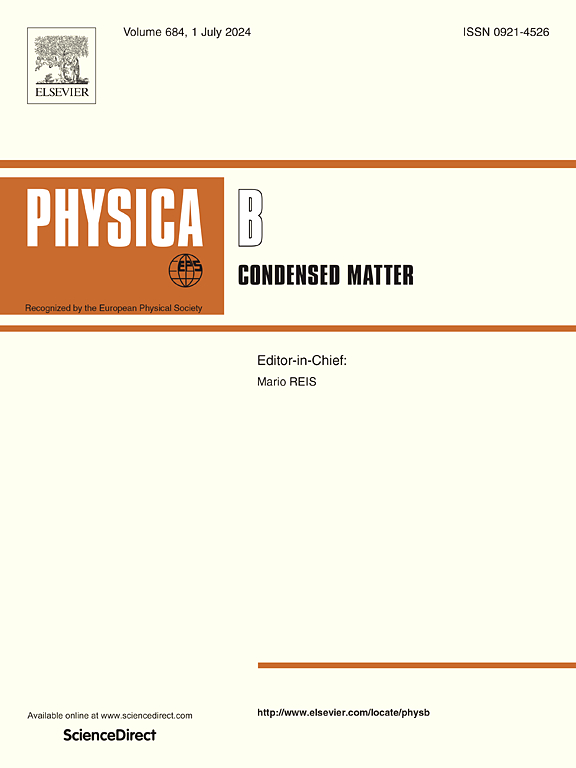Synthesis of nanocurcumin conjugated titanium dioxide bio-nanocomposites for enhanced optical, electrical, and antibacterial applications
IF 2.8
3区 物理与天体物理
Q2 PHYSICS, CONDENSED MATTER
引用次数: 0
Abstract
This study explores the synthesis of nanocurcumin (NCur) and its impact on the structural, electrical, and antibacterial properties of titanium dioxide (TiO2) through a simple solvent-free mechanical mixing. FTIR confirmed NC-TiO2 interactions, while UV–Vis spectroscopy showed a red shift and a reduced bandgap from 3.571 eV to 2.550 eV. XRD verified the crystalline retention of TiO2. Morphological analysis using optical microscopy and FE-SEM showed uniform NCur dispersion in TiO2 up to 6 wt%, beyond which agglomeration occurred. Electrical impedance studies demonstrated a 1.127-fold increase in conductivity at 100 Hz and a reduction in activation energy from 5.37 × 10−5eV to 5.00 × 10−5 at 6 wt% NCur. Additionally, the dielectric constant increased by 29 %, enhancing the material's energy storage potential. Antibacterial assays indicated that TiO2/NCur bio-nanocomposites exhibited significant antibacterial activity against E. coli, increasing efficacy by 183.33 %. These multifunctional properties make TiO2/NCur composites highly promising for applications in biosafe electronics, energy storage, and antibacterial technologies.
合成纳米姜黄素共轭二氧化钛生物纳米复合材料,用于增强光学、电学和抗菌应用
本研究通过简单的无溶剂机械混合,探讨了纳米姜黄素(NCur)的合成及其对二氧化钛(TiO2)结构、电学和抗菌性能的影响。FTIR证实了NC-TiO2的相互作用,而UV-Vis光谱显示了红移,带隙从3.571 eV减小到2.550 eV。XRD证实了TiO2的晶体保留。光学显微镜和FE-SEM的形态学分析表明,NCur在TiO2中的分散均匀,达到6 wt%,超过6 wt%会发生团聚。电阻抗研究表明,在100 Hz时,电导率增加了1.127倍,在6 wt% NCur时,活化能从5.37 × 10 - 5eV降低到5.00 × 10 - 5。此外,介电常数提高了29%,增强了材料的储能潜力。抑菌实验表明,TiO2/NCur生物纳米复合材料对大肠杆菌具有显著的抑菌活性,抑菌效果提高了183.33%。这些多功能特性使得TiO2/NCur复合材料在生物安全电子、储能和抗菌技术方面的应用前景非常广阔。
本文章由计算机程序翻译,如有差异,请以英文原文为准。
求助全文
约1分钟内获得全文
求助全文
来源期刊

Physica B-condensed Matter
物理-物理:凝聚态物理
CiteScore
4.90
自引率
7.10%
发文量
703
审稿时长
44 days
期刊介绍:
Physica B: Condensed Matter comprises all condensed matter and material physics that involve theoretical, computational and experimental work.
Papers should contain further developments and a proper discussion on the physics of experimental or theoretical results in one of the following areas:
-Magnetism
-Materials physics
-Nanostructures and nanomaterials
-Optics and optical materials
-Quantum materials
-Semiconductors
-Strongly correlated systems
-Superconductivity
-Surfaces and interfaces
 求助内容:
求助内容: 应助结果提醒方式:
应助结果提醒方式:


